Analyzing Handwriting: Are you a Logical or an Intuitive Thinker?
Graphical continuity is the way in which letters connect with each other in each word. It is the bond or separation of the strokes in a written text. Are your letters joined or disconnected? Evidence shows that people who connect their letters apply logic over emotion.
On the contrary, those who do not connect their letters are impulsive and act on instinct. They use their intuition and imagination. is the graphical aspect in graphology, that indicates the degree of equilibrium and perseverance in ideas and conduct.
The importance of continuity in graphology, is that it expresses the degree of “connection” between desire, thinking and action, what is done by the individual. It reflects “the way of being and doing” of the human being. Graphical continuity comprises three sub-aspects that are cohesion, regularity and variability.
Cohesion: Spacing between Letters and Words
Cohesion analyzes the continuity of the bonds of the letters of each word. Analyzing Handwriting: According to how the prevailing bond in a text is, cohesion will result in:

- Very connected writing
- Connected writing
- Grouped writing
- Disconnected writing
- Combined writing
- Unequal cohesion writing
- Juxtaposed writing
- Fragmented writing
- Lapses of cohesion
- Incisions
We must not mistake cohesion with “connection”. Cohesion is linked to the aspect of continuity, while connection is related to the shape graphical aspect of the bonds between letters.
How to measure Cohesion in Graphology
Cohesion of the writing is given by the bond of the final stroke of letters with the initial stroke of the following letter. Analyzing Handwriting. Cohesion of writing is determined by the percentage of existing bonds between letters in a text. In order to classify writing into connected or disconnected we must calculate the percentage of connected letters and disconnected letters in detail, whether they are uppercase or lowercase. We also analyze cohesion within the same letter (like in the case of connected ovals or ovals separated from the downstroke or from the upper extensions and lower extensions that connect a letter to the other, or the top of letters “m” and “n” fragmented).
Letters that are executed in two strokes (like “t”, or the dot of the “i” are not easy to analyze, since when we place the dot in letter “i”, the bar of the “t”, an accent mark, it is natural to stop, place the period, the bar and return to the writing. We should always use original samples of writing and dispose of all photocopies, where it is hard to identify juxtapositions and we can incur in mistakes.
How should graphical continuity be?
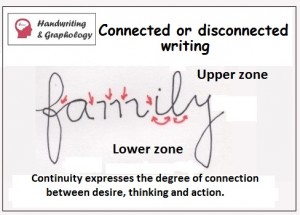
“Healthy” graphical continuity should respond to grouped cohesion, with rhythmic regularity and evolved variability in a positive sense. Progressive, with fluidity, without obstacles, spontaneous, without rigidity, with an order in relation to shape and space, evolved, that acquired maturity, getting over the phase of learning. Graphical continuity which is equilibrated and without excessive cohesion expresses harmony between logical reasoning and deductive-inductive reasoning between thinking and action.
Interpretation of Connected and Disconnected Letters
Each word is the mental representation of a concrete object that will be connected to some experience in our lives. When we mentally represent an object that does not evoke an unpleasant or traumatic experience, an impulse of action and realization is generated without impediments, without interruptions. That is why the writer of connected writing goes from an idea to action without obstacles. Extraversion prevails and he adjusts well to the environment.

In the case of disconnected or juxtaposed writing without air connection, the individual requires support to connect with the environment, is insecure, inhibited, introverted, needs to ”ruminate” the stimuli in order to reflect before acting. Instead of facing situations as a whole, he separates them, like letters from words and analyzes in a partial way, judges, which makes relationships harder. The more inequality in space, shape and movement, the greater the difficulty between continuity between what he thinks and what he does will be.
When writing is disconnected or juxtaposed but there are air connections and the rhythm is progressive, we interpret that as a positive sign.
Cohesion reflects equilibrium between feeling, thinking, and the ability to take it to action. Each “cut” expresses a detention. That is why we must evaluate the rest of the text, in order to determine whether the interruptions are accompanied by progressive movements or there is a predominance of shape in letters resulting in a slow writing.
Graphical continuity is an indicator of health, given that when the fluidity of the stroke is hindered or deteriorated, there is a possibility for early detection of signs of illnesses, either organic or psychological. Graphical continuity is related to the three spheres of personality: intellectual, socio-affective and instinctive.
When the bonds in letters are conjugated in a fluid way in the middle area (area for affection that expresses the present reality of the Ego), there is room for thoughts and impulses to be expressed without interfering in the rhythm. Interruptions may come from excessive reflection, doubts or inhibitions. If the graphism is excessively disconnected, this may express states of deep anxiety or anguish. Graphical continuity expresses the degree of integration of the individual to the environment.
Logical or Intuitive thinking in writing
The more cohesion, the faster the speed of mental processes and logical reasoning, while disconnection expresses more intuition and less ability for reflection. Connection in strokes represents initiative, decision and persistence in activities, without the need to interrupt tasks. Cohesion transmits extraversion and ability to relate socially.
Very Connected Writing
When the percentage of cohesion is too high in lowercase, uppercase ovals and upper connections and lower connections, letters are mostly connected, bonded to each other, it is called very connected writing. Ideas flow naturally, the individual is persistent, possesses great logical capacity and creates good relationships. When he begins a task, he does not like to interrupt it until he finishes the same.
When very connected writing comes together with a lot of movement, it is associated to the need for constant activity, impatience that makes the task more difficult, obstinacy, imperious desire of occupying time, inability to stay away or take distance from situations in order to reflect. They are pragmatic with limited creativity.
What is Connected Writing?
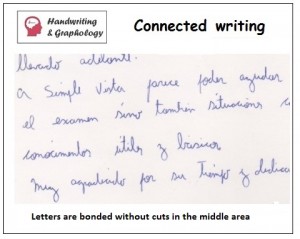
Writing is considered connected when the percentage of bonds ifs high, especially in lowercase letters. Connecting is bonding. Letters are bonded without cuts in the middle area, and are only interrupted to place a dot, accent marl or “t” bar. This writing is associated to progressive writing and reflects a personality that is able to fusion up and identify with, by affinity or empathize with the other without impediments. Participates and integrates without reservations, enjoys contact with each person or situation. Extroverted, feels no fear, there are no obstacles that stop him. He is not inhibited before contact with the outside and is able to put ideas into practice, his desires and vital needs. It is the writing of individuals with a practical sense who achieve greatly positive results, who relate ideas and arguments with logics and mental ability. Sociable, extroverted, persistent, tenacious, emotionally stable.
Grouped Writing

When the percentage of bonds is intermediate, (of 50% approximately) and words are formed by letters that connect in two, three or more, it is called grouped writing.
Those who write this way have a great ability for adaptation of their inner lives to circumstances that life provide, equilibrium between reflection and impulse, introversion and extroversion, isolation and sociability, submission and independence.
At work, their rhythm is fluctuating, is goes by with moments of activity and others of passivity. As we always recall, we need to keep the graphical context in mind. In a negative way, these movements may cause dissatisfaction, insecurity and instability in bonds.
Disconnected Writing
It is the one where letters in the same word are separate. There is no continuity, no bonds or connections. Those who write with disconnected or juxtaposed letters have an analytical and critic thinking. They feel forced to separate, shred matters in order to understand them, which induces them to stop thinking. Detains in details instead of the whole, divides in order to study in depth, and assure that there are no dangers that will harm him. Reflects a defensive attitude towards the environment. This attitude is the introversion that Carl Jung refers to and the Secondary of Heymans-Le Senne.
Rational and Intuitive Thinking in Handwriting
It presents difficulties in continuity of thinking and activities. Prudence and reflection result in slower thinking processes, impossibility to appreciate the whole and only stopping in details. Although he achieves the production of work satisfactorily, he needs a period of rest in order to recover when finishing a task. Although there is a tendency for introversion and isolation in these individuals, they manage to overcome situations in social relationships. They are cautious and saving. They are inconsistent individuals who suffer emotional instability. In the negative sense, there is a lack of practical and logical sense. Egocentric tendencies. They have monotonous and regular ways of writing and may express mental weakness.
Very Disconnected Writing
Separation of letters is excessive. Almost every element is disconnected. Excessive reflection that stops decision making, extreme intuition, possible blocks, impossibility to continue tasks, irregular work activities, introversion, isolation, self-control.
Combined Writing
In this type of graphism, the graphical elements are bonded through singular and original bonds (they are associated to simplifications of the shape aspect); for example, starting from a dot, or the “t” bar, a stroke that bonds one letter to the next one with a very dynamic movement is done. It results in a fast writing, which is executed with naturality and originality. It expresses mental agility, creativity, vivacity, initiative, ability for association and assimilation of ideas and deduction, memory, quickness for thinking. It provides an idea of synthesis, abbreviation, summing up, and concentration in the essential. From the negative point of view with soft or loose writing, it may reflect laziness, intellectual fatigue, hasty deductions and disorder signs.
Juxtaposed Writing
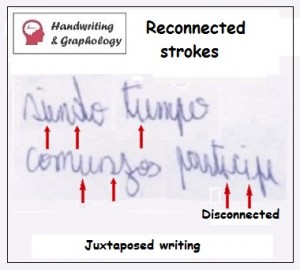
Strokes appear connected at first sight, but looked at closely with a device or magnifying glass we can see they are reconnected. We need to differentiate this from typographic or script writing.
Disconnected and juxtaposed writing: Connected writing expresses the need for contact with the environment. It expresses the idea towards the action without obstacles or impediments and expresses feelings spontaneously. In juxtaposed writing, just like in disconnected writing we identify people with the need for reflection, thinking and observing before deciding or acting. Any cut or incision is a shadow that interposes between the Ego and the Id, between desire and action, between impulse and the governing conscious. Incision is a term introduced by Trillat in order to refer to the cuts that appear in some connections of letters in words. He classifies them into: Initial incision, central incision, phonetic incision (cut in syllables) and constant incision (disassociated letters). Suppression of the graphical impulse expresses a block in thinking and in nervous activity that, according to the rest of the context, will provoke an alert on the professional.
In reconnected writing it is also fundamental to determine the graphical environment. If we are before a writing of a positive graphical environment, of a good level, strokes that flow, it denotes difficulties in social bonds that are attempted to be dissimulated and superficial relationships are established. If the graphical environment is negative, with a slow writing, of a low level, clumsy (like children´s), we infer difficulty to create ideas, insecurity, adaptation difficulties, selfishness, lack of practical sense, slowness in decision-making.
Fragmented letters in Writing

In this case, the cuts appear inside the same letter, being disarticulated (for example, the ovals that are disconnected from the downstroke in the case of letters “d” and “g” or an “m” in three parts). It is disconnected writing, taken to extreme. It is interpreted as a subconscious process that disturbs, hypersensitivity, anxiety, predominance of intuition, introversion, and withdrawal of the individual. With a shaky writing (torsions, swings, shakes, retouches, we infer the presence of organic sufferings (respiratory, circulating, neurologic) that provoke anxiety, uncertainty and anguish. Disintegration of the personality.
Types of Cohesion
- Uniform cohesion: In this case, the type of cohesion (whether they are connected, disconnected or grouped letters) is preserved without great modifications. This means that what is reflected from the psychological point of view is that the individual is constant in his life (working rhythm, bonds, vitality).
- Unequal cohesion: Not only we analyze the inequalities of cohesion in a same text, but we also take into account the differences of a writing to another. This reflexes hesitations, doubts, inner fights, indecision, ambivalence, great emotive nature, emotional instability, compulsive behavior.
The zone of writing in which the inequality is presented will influence the corresponding personality sphere. Inequality is a sign of receptivity and sensitivity due to exaggerated emotive nature. If it appears in the superior area, it will have a different interpretation than if found in the middle or inferior area.
What are Lapses of Cohesion in Graphology?
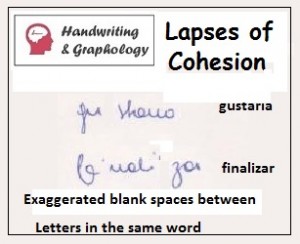
Lapses of cohesion are exaggerated blank spaces found between letters in the same word (from the point of view where the graphism interrupts a letter to the point where movement is resumed in the interior of the same word). Term coined by Augusto Vels in 1945. Any abnormal interruption of the graphical wave supposes an interrupted impulse, an inhibiting defense mechanism that acts trying to avoid anguish. This lapse on occasions is so powerful that might develop the appearance of retouches, mistakes, clumsiness in writing of letters and following words. It indicates fear, indecision, repression, very severe Superego, shyness, lack of trust, prudence, locked thinking, desire for perfection. Ion the negative side: anguish, hesitation, doubt, insecurity, inability to solve situations quickly.
Analyzing Handwriting: Regularity
Regularity is a sub-aspect of continuity, very studied by Klages. Accepted only in the scholar model and must not be admitted as acceptable in adults.
- Regular writing: It is considered regular when movements are constant, uniform, respond to an effort of disorder and organization. It is typical in organized people, with predominance of will over emotions or instincts. Puritanism. If it presents angles, it would indicate inflexibility. Difficulty in adaptation and approaching, but when achieved, they are loyal and committed individuals. On the negative side, they may be routine and rigid individuals. Rigidity of the graphism hides neurosis and psychosis.
- Irregular writing: There are inequalities and disproportions in height, width, slant and direction. Disproportions affect one or all graphical aspects. Open intelligence and receptive to new stimuli. Predominance of emotions over reason, weak will, ambivalence, inconstancy, changing individuals of instable bonds.
Analyzing Handwriting: Variability
It reflects the changes that are produced in the graphism along life.
- Constant writing: In writings of different moments of the same individual, in which we do not perceive variations from one text to another.
This is interpreted as low emotive nature and impressionability. Firmness, security, trust in oneself. Constant and stable in tendencies and decisions, friendly relationships and affective bonds. It may be hard to express feelings. With a harmonic writing, fidelity and loyalty. With round writing, slow and uniform: Passive stability, of constant costumes that makes him predictable, apathy, routine, conventionalism. It is associated to phlegmatic temper.
- Evolved writing: The development of the graphism is usually proportional to the maturity of character and personality. Evolved writing is the one that has acquired such a degree of maturity that may be described as NORMAL, has overcome the stages of learning, flows in a natural way, without obstacles, it is appreciated in the form, direction and dimension. Mental evolution, affective, spiritual, social and professional maturity.
- Regressive writing: The same way personality regresses and moves backwards instead of growing and maturing, writing also can regress due to illnesses sufferings, changes in lifestyle and profession.
- Inconstant writing: There is no similarity between writings of the same person: Instability, emotive nature, impressionability, typical in melancholic temper.
This concludes the article about Analyzing Handwriting. Feel free to share it with your contacts if you found it useful. Keep reading this blog to learn more about Learn Graphology: What does your handwriting say about you and Letter i in handwriting Analysis. Follow us on Facebook!

Read also: Definition: What is Handwriting Analysis?

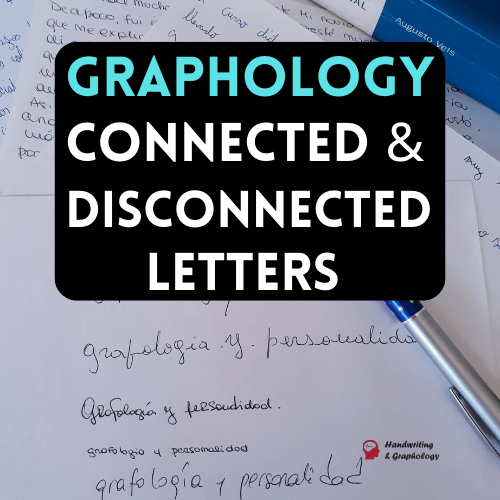

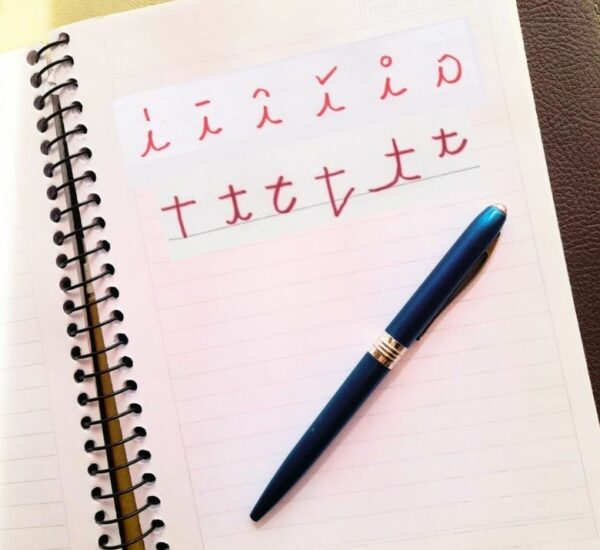
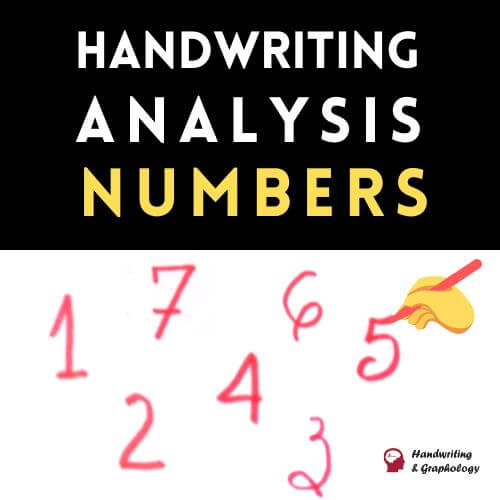
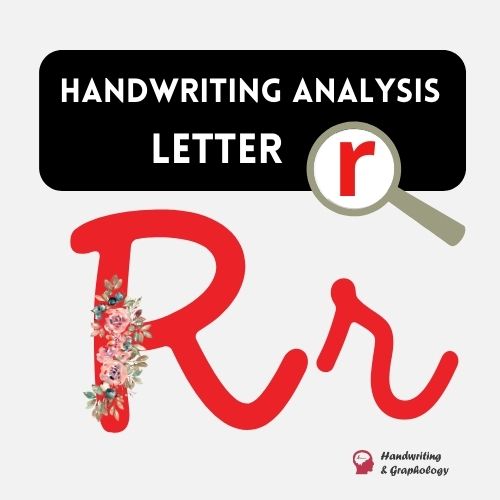
I enjoyed reading the interesting. psychological insights of varies writing/letter formations. Am not sure what continuity is, but I think I have it :-). I do write with some disconnected letters at times; though when I was a teacher I worked to improve that for the students’ sake. I remember that at a certain age – maybe fourth of fifth grade, I made a decision that I have stuck with – to stop when it was too difficult to connect a letter nicely and write it